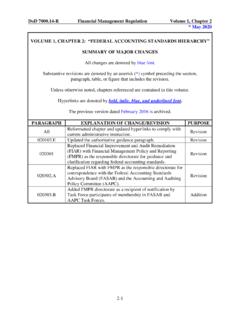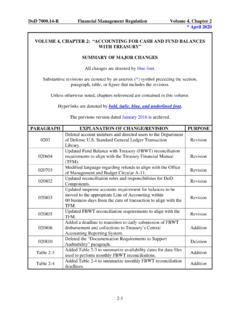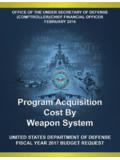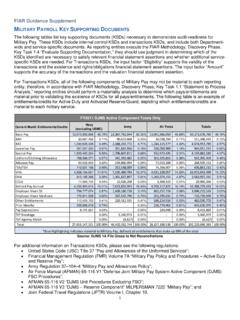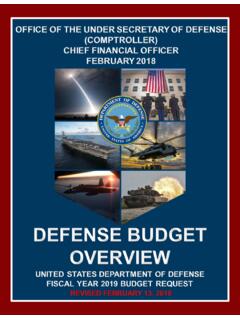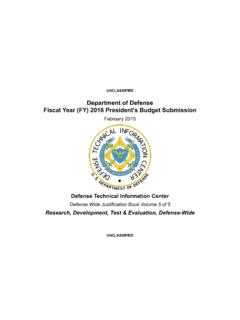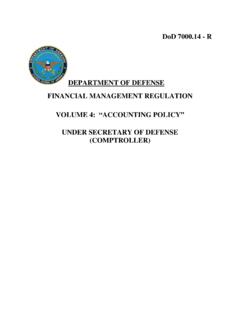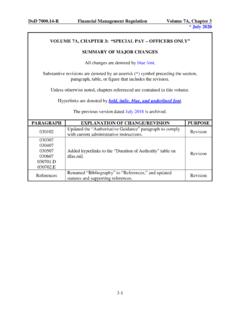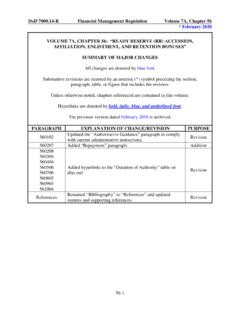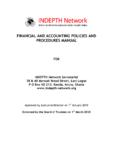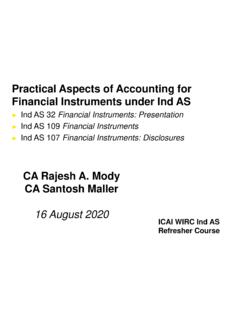Transcription of Standard Line of Accounting (SLOA)/Accounting …
1 Attachment Standard Line of Accounting (SLOA)/ Accounting Classification Data Element Name (Length); SFIS reference ( ); Examples Sub Classi (2): A7 in SFIS; Grouping of a transaction type, , 46 Payments from Current Appropriations for Obligations of Closed Accounts; Sub-level Prefix (SP) Department Transferi (3): A2 in SFIS; A transfer of obligation authority from DOE, , 089; Allocation Transfer Agency Identifier (ATA) Department Regulari (3): A1 in SFIS; , 021 Army, 017 Navy, 057 Air Force; 097 ODOs; Beginning Period of Availability Fiscal Year Datei (4); A27 in SFIS, , 2012 Ending Period of Availability Fiscal Year Datei (4); A28 in SFIS, , 2012 Availability Typei (1): A24 in SFIS; , X = No-year TAS Main Accounti (4): A3 in SFIS; Synonymous with Basic Symbol, Appropriation Symbol, , 4930 Sub Accounti (3): A4 in SFIS; Indicates the relationship to the Main Account, , 002 Business Event Type Codeii (8); T20 in SFIS; Replaces Transaction Codes, , DISB - Disbursement Object Classiii (6); B6 in SFIS; Will initially be implemented at the three-digit level as in SFIS with room to expand to six, , 252 Reimbursable Flagi (1); A9 in SFIS.
2 Examples: Direct, Reimbursable Code, , D or R Budget Line Itemiii (16); For MilPers, value will be Budget Sub-Activity (BSA) plus Budget Line Item (BLI). B4 in SFIS; Further sub-divides the Treasury Account Fund Symbol below sub-activity, , 111 Security Cooperation (formerly Foreign Military Sales (FMS) Customer Code)iv (3); T21 in SFIS; Security Cooperation (SC) Customer; The country, customer, or program receiving the product/service, , EI IRELAND or F1 F-16 CO-PRODUCTION, or B4 SECTION 1206 Security Cooperation Implementing Agency (IA) Code iv (1); T27 in SFIS; Identifies the MILDEP or agency which is executing the FMS sale on behalf of the Government.
3 , B-Army, D-Air Force, P-Navy Security Cooperation Case Designator (formerly known as FMS Case Identifier )iv (4); T22 in SFIS; Identifies the FMS or Security Cooperation contractual sales agreement between countries, , UAK Security Cooperation (formerly FMS) Case Line Item Identifieriv (3); T23 in SFIS; Security Cooperation (SC) Customer; Identifies a detailed line-item requirement, , 001 2 Sub-Allocation (formerly known as Limit )iii (4); Use of this data element is exclusive to sub-allocation purposes, useful for financial Reporting; , 2504 Agency Disbursing Identifier Codeii (8); O2 in SFIS; Synonymous with Treasury DSSN definitions for each disbursing office, , 1700 Agency Accounting Identifierv (6); O3 in SFIS; Fiscal Station Number; Comptroller defined; Identifies the Accounting system responsible for the Accounting event , 021001 DFAS Indianapolis (GFEBS) Funding Center Identifiervi (16); cost Object/ cost Accounting (CA) section in SFIS; , Army = Funds Center, ASN; Air Force = OAC, OBAN; Navy = BCN cost Center Identifiervi (16); CA section in SFIS; , Army = cost Center, ASN; Air Force = Resource Center/ cost Center (RC/CC); Navy = BCN Project Identifiervi (25).
4 CA section in SFIS; , Army = WBS; Air Force = Project; Navy = WBS ( cost Code) Activity Identifiervi (16); CA section in SFIS; , Army = Activity/Network; Air Force = Activity or Special Project; Navy = Activity cost Element Codevi (15); CA section in SFIS; , Army = Commitment Item; Air Force = Element of Expense Investment Code (EEIC); Navy = cost Element Work Order Numbervi (16); CA section in SFIS; , Army = Internal Order; Air Force = Job Order; Navy = Job Order ( cost Code) Functional Areavi (16); CA section in SFIS; , Army = Functional Area; Air Force = Budget/Project i Treasury Account Symbol (TAS) data elements requirement for the Treasury s Central Accounting and Reporting System (CARS)/Government Wide Accounting (GWA).
5 also a Payment Information Repository (PIR) requirement ii Requirement for the Treasury s PIR iii Office of Management OUSD(C) Program/Budget for the AR(M) 1002 Report iv Security Cooperation transaction requirements v DFAS requirement vi Component requirements, based on the cost Accounting standards in Statements of Federal financial Accounting Standards (SFFAS) #4 The data elements in italics will have either updates/corrections/SFIS Business Rules established in an update to the BEA, targeted to be in the BEA 3 Initial SLOA Implementation Plan Template (an Excel template will also be provided on ): The Plan should address unreconciled differences caused by interoperability with trading partners or customers systems by: (A) Analyzing existing functionality and cost -efficiency within a mixed Legacy and Target and/or Enterprise Resource Planning (ERP) systems environment.
6 (B) Determining the best way forward to resolve inherent data exchange problems. (C) Consolidating functionality by reducing the overall number of systems and thereby interfaces, which pass transactional data. (1) This should be based on a DoDAF SV-6 structure outlining each of the system s interfaces. (2) Each interface is required to be labeled as Target or Legacy. (D) Evaluating if those systems/interfaces can be subsumed by the Target and/or ERP systems. (1) Each interface is required to be labeled as Subsumed or Maintained. (2) Each interface is required to be labeled as SLOA Applicable or Not Applicable.
7 (3) Rule of thumb: Those that are Target (C)(2), which will be Maintained (D)(1), lead to postings between commitments and disbursements; and Those that are Legacy (C)(2), which will be Maintained (D)(1), should be noted with a comment specifying why these Legacy interfaces are critical/applicable. (E) Implementing the SLOA for the remaining interfaces. (1) Projected dates (MM/YY) are required for subsumption or SLOA implementation. System owners and Service Providers must also ensure that their systems are interoperable with their trading partners or customers systems with respect to this requirement.
8 Certain cases may require a business process reengineering effort to effectively execute this requirement. Components should identify this in their SLOA implementation plans. (2) Participating in SLOA coordination discussions with the Office of the Under Secretary of Defense (Comptroller)/Deputy Chief financial Officer and the Office of the Deputy Chief Management Officer after their receipt of the Component-level plans to form an Enterprise SLOA Transition Plan with targeted completion dates. 4 Note: Items (C)(1) through (D)(1) should already exist, given that for (C)(1) and (C)(2) Target systems should have an SV-6 and given that (D)(1) was a requirement associated to FY2010 National Defense Authorization Act (NDAA) IRB certification.
9 If items (C)(1) through (D)(1) have been done properly, then items (D)(2) & (E)(1) should be an intelligible task. Additional Guidance & Information (Updates will also be provided on ): In the current systems environment, legacy and target systems are either configured or cross-walked to SFIS for external reporting purposes, in accordance with title 31, , section 3512(b), and the Federal financial Management Information Act of 1996, section 803(a) (Pub. Law 104-208, Div A, Title VIII, 31 USC sec 3512 note). These systems must be able to cross-walk trial balance data to the Defense Departmental Reporting System (DDRS) for DoD s consolidated/enterprise-level reports, for external stakeholders.
10 Procurement and financial management communities developed the financial Data in Procurement (FDIP) concept which linked financial data to contract documents (USD(C)/CFO and Under Secretary of Defense for Acquisition, Technology and Logistics Memorandum, Linking financial Data to Contract Documents, March 18, 2009.) The establishment of a DoD SLOA expands the FDIP concept to all functional areas, across the DoD, that generate general ledger information. This SLOA will, at the line-item level, enhance interoperability and enable the enterprise to move forward toward a target environment, link budget to execution, assist with the reconciliation of multi-funded contracts, and reduce unsupported Accounting adjustments for improved auditability.
